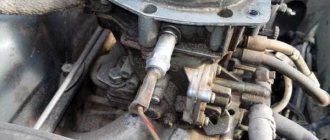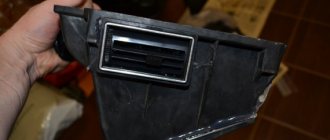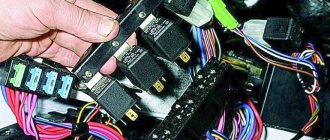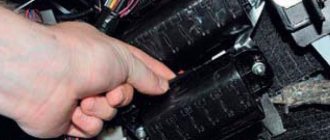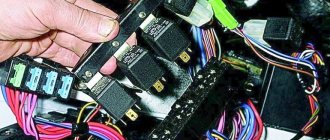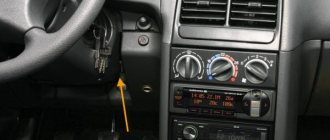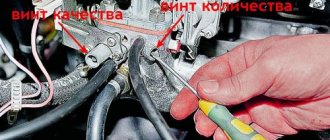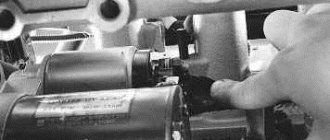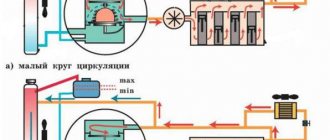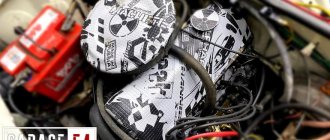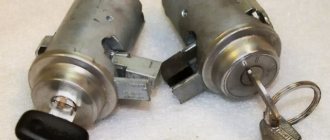Glitches of the tachometer and temperature indicator
Reg.: 12/06/2004 Topics/Messages: 628/51730
Reg.: 07/28/2005 Topics/Messages: 1/2646 From: Ivanovo Age: 44 Car: Nivka2121. g.v. worn-out 1.9i and other minor tuning Murzik MV 300TD 1993
Reg.: 12/06/2004 Threads / Messages: 4029 / 23189 From: Moscow Age: 66 Car: 21214M, 2013
Yes, it's a lot. Possibly a ground between the body and the engine (the sensor's ground goes through the engine), but most often the nut under the dash. Look at the root of the “Electrical” FAQ section for an article about the most common cause of electrical glitches.
Added after 40 seconds:
I'll move it to the "Electrical" section.
Alexey aka ALER.
Reg.: 12/06/2004 Threads / Messages: 628 / 51730
Reg.: 04/10/2005 Topics / Messages: 1 / 107 From: Gagarin Age: 47 Car: Chevy Niva 2123. 2008
Reg.: 12/06/2004 Threads / Messages: 628 / 51730
Niva 21213. 99
The coolant temperature gauge on a warm engine consistently shows 110*C. Changed the sensor - no change!
The tachometer needle “jumps” on the scale.
Reg.: 01/12/2005 Messages: 112 From: Moscow, Lyublino Age: 57 Car: 2131 1.7 carb. 2000
Look at the instrument panel. I had a similar experience when, due to overheating of a 51 Ohm 5 W resistor, the printed circuit board underneath it burned out and a couple of tracks broke. I recommend replacing the resistor with 2 pieces of 100 Ohm 5 W connected in parallel. Second option: something with a power supply stabilizer for the thermometer and tachometer. It is located there on the dashboard board and is implemented differently in panels from different manufacturers.
Reg.: 12/06/2004 Threads / Messages: 4029 / 23189 From: Moscow Age: 66 Car: 21214M, 2013
But this usually indicates problems in the ignition system. If you have a “dry” coil, it may be because of it. Although the same bad mass may appear.
It is better to add the make and year of manufacture of the car to the signature using the Profile link in the top menu.
sko
Alex F
has a car from 1999, there is no stabilizer. It was only in the Hungarian panel, which was staged until 1998. In the Vladimir panel, only the tachometer has its own stabilizer, and stabilization of the indicator readings is ensured by their special design. Due to burnt-out tracks, this also cannot happen - then some circuits simply would not work.
VAZ-2106 tachometer connection diagram
The “Sixes” were equipped with a tachometer model TX-193. This tachometer consists of:
- plastic cylindrical body with glass holder;
- a scale divided into zones of safe and dangerous modes;
- backlight lamps;
- a milliammeter with an arrow attached to its shaft;
- electronic printed circuit board.
The principle of its operation is based on measuring the number of electric current pulses in the primary (low-voltage) circuit of the car’s ignition system. In the VAZ 2106 engine, for one revolution of the distributor shaft, corresponding to two rotations of the crankshaft, the contacts in the breaker close and open exactly four times. These pulses are removed by the device from the final terminal of the primary winding of the ignition coil. Passing through the parts of the electronic board, their shape is converted from sinusoidal to rectangular, having a constant amplitude. From the board, the current flows to the winding of the milliammeter, where, depending on the pulse repetition rate, it increases or decreases. The arrow of the device reacts precisely to these changes. The greater the current, the more the arrow deviates to the right and vice versa.
Connecting a tachometer in carburetor VAZ 2106
Electric circuit of the speed counter of the carburetor “six”
In a contactless ignition system, the tachometer is connected not to the coil, but to the switch
Connecting a tachometer in injection VAZs
It should be taken into account that the colors of the wires and their purpose may differ depending on the manufacturer of the device, but for the standard “TX-193” device, which is usually used in “sixes”, the diagram is as follows:
- A white cable is required to connect the backlight.
- The red wire is connected to the ignition switch, a fuse is used for this, this cable supplies power when the ignition is activated.
- A white cable with a black break is required for connection to the car body.
- The brown wire connects to the K+ terminal on the coil.
- The black wire is connected to the charging current indicator relay. The latter, in turn, is installed on the right in the engine compartment.
- The gray-black cable is required to connect to the engine fluid pressure regulator installed to the left of the engine.
The tachometer needle twitches. The tachometer does not work.
- Go to page:
The tachometer needle twitches. The tachometer does not work.
Post by _JJ » Jun 30, 2010, 11:47 am
Re: Tachometer needle twitches.
Post by Pilot » June 30, 2010, 12:13 pm
Re: Tachometer needle twitches.
Post by Anton » June 30, 2010, 13:10
Re: Tachometer needle twitches.
Post by Captain » June 30, 2010, 2:15 pm
Re: Tachometer needle twitches.
Post by Portada » June 30, 2010, 4:25 pm
Re: Tachometer needle twitches.
Post by ALK » June 30, 2010, 4:35 pm
oops... what if the needle goes down? we stand at xx - 0 and hit the limiter.. or vice versa.. if you accelerate in a traffic jam - and you have 8 tyres, or even more
the tracks are in good working order, because sometimes the tachometer shows the true values.. :) 2 tidy devices like this)
Who knows what's going on behind the fence of the zoo? ©
Re: Tachometer needle twitches.
Post by Portada » Jun 30, 2010, 4:40 pm
Re: Tachometer needle twitches.
Post by ALK » June 30, 2010, 4:41 pm
Who knows what's going on behind the fence of the zoo? ©
Re: Tachometer needle twitches.
Post by Portada » Jun 30, 2010 4:43 pm
Re: Tachometer needle twitches.
Post by simbir » 04 Jul 2010, 21:42
Re: Tachometer needle twitches.
Post by ALK » 04 Jul 2010, 23:12
The fuses have long been knife-edge...
There are 3 “wires” on the ugly pin. the rest of the consumers are working
either there is a problem with the mass wire or with the “supply”
Who knows what's going on behind the fence of the zoo? ©
Re: Tachometer needle twitches.
Post by _JJ » Jul 12, 2010, 12:50 pm
Re: Tachometer needle twitches.
Post by Captain » Jul 12, 2010, 01:08 pm
Re: Tachometer needle twitches.
Post by Anton » July 12, 2010, 1:12 pm
Re: Tachometer needle twitches.
Post by Portada » Jul 12, 2010, 01:48 pm
Re: Tachometer needle twitches.
Post by _JJ » Jul 12, 2010, 03:16 pm
Re: Tachometer needle twitches.
Post by simbir » Jul 13, 2010, 00:44
Re: Tachometer needle twitches.
Post by _JJ » Jul 13, 2010, 10:03 am
Re: Tachometer needle twitches.
Post by ALK » Jul 18, 2010, 9:41 pm
Let's flex our cerebellums and brainstorm. otherwise I'm already sweating..
The situation is this: there is a tachometer, there are different panels on which this glitch appeared. but the tachometer works in a very curious mode... sometimes it works when the engine starts, sometimes it doesn’t want to start, sometimes it “wakes up” while driving, especially at high speeds with high revs, sometimes in a traffic jam for 10 thousand the needle can fall off. I broke my whole brain.
was changed and repaired:
the coil was replaced last year the mass on the notorious stud was re-tightened the interior wires were carefully inspected the connector under the hood is executed once a year the canopy unwound one beetle (the rat chewed it up, it had to be wound up for a short time forever)
) - everything is fine, copper is far from a green mass? I threw the mass from the pin of the instrument cluster, it makes the tracks burn wonderfully
Should I run the wire directly from the coil? The tricky part is that sometimes the tachometer comes to life
Connection diagram for tachometer VAZ-2108 and 2109
Let us immediately note that the fuel supply system – injector or carburetor – does not play a special role here. As you know, currently the most common are cars with the following engine types: gasoline or diesel. Depending on this, the tachometer is selected, unless, of course, it comes in the stock version. The thing is that on gasoline engines the tachometer reads data from the ignition coil, or rather, the impulses that arise here. However, the design of diesel power plants does not provide for this unit. Accordingly, here the tachometer reads pulses not from the ignition coil (for lack of one), but from the generator.
The first two wires (12-volt and Signal) are to contacts “B” and “K” of the ignition coil, respectively. All that remains is to secure the mass in any convenient place.
Useful: VAZ starter connection diagram
Tachometer Niva 21214 injector does not work
An official discussion of the question why the tachometer does not work on Niva 21214, answers from three users are available on the site. Instructions and video response are available.
Video quality: PDTV
The video was uploaded to the admin from user Avl: for immediate viewing on the portal.
To give the correct answer to the question you need to watch the video. After viewing, you will not need to seek help from specialists. Detailed instructions will help you solve your problems. Enjoy watching.
Humor on topic: As a child, my mother forbade me to talk to strangers. Therefore, the equations had to be solved silently.
Messages: 126 Registered: Jul 17, 2010, 00:00 Car: Audi A5/BMW 1(e87)/
Thanked: 3 times Thanked: 1 time
Post by thudic » Nov 16, 2012, 10:28 pm
there is a problem with the injectors) you can throw a separate one where the brains are located) they are taken from the engine where the thermostat is)
Added after 32 seconds:
and another mass should be near the driver’s left foot somewhere there) if I’m not mistaken)
Added after 15 seconds:
and another mass should be near the driver’s left foot somewhere there) if I’m not mistaken)
Messages: 549 Registered: 01 Oct 2008, 00:00 From: Tyumen Experience: since 2006 Car: AUDI Q7 :
Awards: 1
Thanked: 2 times Thanked: 1 time
Post by Vadosik » 17 Nov 2012, 15:57
The electrician now had the gas and it shows the temperature, he said about the tachometer, come back later and I’ll take a look.
Modern AvtoVAZ SUVs use injection power units. If a malfunction is detected in the electrical equipment of the car, you should first check the serviceability of the fuses and relays. Next, we will show where the mounting block is located (fuse box or black box), as well as the location of the elements inside it.
Can a damaged tachometer be repaired?
Having determined why the tachometer does not work, it should be noted that Niva cars were produced with injection and carburetor engines. The method of connecting the rotation sensor on these types of internal combustion engines is different. If the device becomes damaged or worn out, it will likely require replacement. Moreover, the new tachometer must be selected taking into account the characteristics of the internal combustion engine and other design features of the machine.
In some cases, replacing the shaft position sensor will allow you to restore stable operation of the rotation counter. This element is responsible not only for generating pulses during shaft rotation, but also for determining its position in a specific period of time, which is necessary for correct control by the ECU.
If the problem lies in electrical circuit defects, the following actions are recommended:
- strengthening the fixation of contacts on the minus terminal;
- replacing contacts on the ignition distributor;
- replacing the crankshaft bearing, which is involved in the formation of pulses in the sensor;
- comprehensive insulation of supply wires.
In the vast majority of cases, it is recommended to replace a faulty tachometer rather than repair it. This is due to the fact that even after repair, you cannot be sure that the device reflects reliable indicators.
You can replace the tachometer on a Niva as follows:
- Remove the instrument panel glass using a screwdriver.
- Disconnect the block on which the wiring harness is fixed from the tachometer.
- Unscrew the fasteners by hand or with pliers.
- Remove the inactive device from the recess in the housing.
- Install a new tachometer and secure it with fasteners.
- Connect to the on-board network.
When replacing, it is necessary to take into account that a limited number of tachometer models are compatible with VAZ cars. In this case, it is necessary to take into account the year of manufacture of the vehicle. Older models have carburetor internal combustion engines, while newer ones have injection engines.
Location of fuse and relay blocks Niva 4x4
The main part of the fuses are located in the Niva's interior under the panel to the left of the steering column. Total 4 blocks:
1 — engine control system fuse box; 2 — windshield wiper relay; 3 — fuse blocks; 4 — relay block of the engine control system.
The fourth relay block is located above the gas pedal.
Main and additional fuse blocks
These two blocks are connected to each other. There are 10 fuses in the upper block, and 6 in the lower one. Markings from left to right:
Heater fan, rear window defroster, rear wiper and washer system, windshield washer pump
Steering column switch, windshield wipers, hazard warning lights, breaker relay (in turn signal mode), reverse light, instrument cluster (coolant temperature gauge, fuel level gauge, tachometer, warning lights: turn indicators, differential lock, parking brake, emergency condition of the working brake system, insufficient oil pressure, fuel reserve, battery charge)
Left headlight (high beam), high beam indicator lamp
Right headlight (high beam)
Left headlight (low beam)
Right headlight (low beam)
Side light lamps in the left front and left rear lights, license plate lights, side light indicator lamp
Side light lamps in the right front and right rear lamps, backlight lamps for the instrument cluster, cigarette lighter, switches, heating and ventilation control unit
Hazard switch, breaker relay (in hazard mode), heated tailgate glass relay contacts
Sound signal, interior lamps, brake lamps in the rear lights
Fog light relay contacts in rear lights
Engine Control Relay Box
Below the main and additional fuse blocks there is a relay block for the engine management system, which consists of five relays and one fuse:
On some vehicle versions, a starter relay may be located under the additional unit next to the ignition relay.
Mounting blocks for Lada 4×4 2018
The main and additional units are located in the cabin to the left of the steering wheel, under the instrument panel. The blocks contain fuses of the “Cylinder” size, ten and six fuses, respectively. The ratings and purpose of the fuses are indicated in Table 4 “Circuits protected by fuses”:
Fuse block of standard size “Standard”. The block is located on the left side under the upholstery and contains fuses that are designed to protect engine control system devices. The ratings and purpose of the fuses are shown in Table 5:
The fuse and relay box is located on the left side of the steering column under the instrument panel. The block contains two “Standard” size fuses, which are designed to protect the circuits of the electric fuel pump, electric windows and electric mirrors. The ratings and purpose of the fuses are shown in Table 6:
The fuse and relay box is located on the right side of the steering column under the instrument panel. The block contains one “Maxi” size fuse and two “Standard” size fuses, which are designed to protect the circuits of the hydraulic unit of the anti-lock braking system. The ratings and purpose of the fuses are shown in Table 7:
Attention!
The relay and fuse diagram may differ depending on the configuration and production date of the vehicle. Current diagrams of the mounting block are presented in the operating manual for the date of manufacture of the car (download from the official website for 3-door or 5-door).
Why does a fuse or light relay or any other constantly blow out? Before replacing it with a similar one, you must first find and eliminate the cause of its burnout. This could be a short circuit, incorrectly selected rated current, etc. Use electrical circuit diagrams to troubleshoot problems. Questions on this topic can be asked on the forum.
How does the tachometer work?
A standard automotive device for measuring crankshaft rotation speed consists of several elements: a measuring unit, a transducer, and an indicator unit. The device can also be equipped with auxiliary elements.
The device responds to shaft rotation and displays the current reading on a mechanical dial or electronic display. To read the speed, the design includes a sensor that is fixed in close proximity to the crankshaft. During rotation, an electrical impulse is generated, which is subsequently transmitted to the display unit.
Tachometer readings are approximate. This device is not characterized by high accuracy. The error varies depending on the type of construction.
First of all, tachometer indicators are used when choosing the optimal gearbox gear. Also, the values on the dial are taken into account when determining the speed limit for specific conditions and types of road surface.
Data from the meter allows you to select the optimal engine operating mode and reduce potential excess load. In case of malfunctions on the motor side, the tachometer will allow you to promptly identify the breakdown or evaluate the quality of work after repair.
Despite the fact that modern cars use electronic control systems, mechanical tachometers remain relevant. This is especially true for outdated domestic models.
